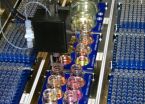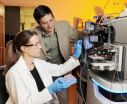(Press-News.org) Investigators in the Massachusetts General Hospital (MGH) Center for Systems Biology have discovered a previously unknown type of immune cell, a B cell that can produce the important growth factor GM-CSF, which stimulates many other immune cells. They also found that these novel cells may help protect against the overwhelming, life-threatening immune reaction known as sepsis.
"B cells are a family of white blood cells that secrete antibodies, and GM-CSF induces the production or activation of granulocytes and macrophages, other white blood cells that have specific roles in the immune system," says Filip Swirski, PhD, of the MGH Center for Systems Biology, senior author of the report that is to be published in the journal Science and is receiving advance release on the Science Express website. "Our findings are surprising not only because B cells were not previously known to produce GM-CSF in vivo but also because they indicate these novel cells initiate an important immune response."
As part of a separate investigation, Swirski and his team analyzed production of GM-CSF (granulocyte macrophage colony-stimulating factor) in tissue from several important organs. They were surprised to find that application of a bacterial molecule known to produce a powerful immune response induced GM-CSF production by what turned out to be a previously unknown family of B cells in the spleen. Because GM-CSF is known to activate white blood cells as part of the innate immune response – the body's first line defence against pathogens – the novel cells were named innate response activator (IRA) B cells.
The researchers went on to identify distinguishing characteristics of IRA-B cells, including gene expression patterns not seen in other B cells. They also determined that IRA-B cells derive from B cells known as B1a B cells. These IRA-B cell precursors originally reside in the peritoneal cavity but, after detecting the presence of invading bacteria, travel to the spleen or bone marrow where they differentiate into IRA-B cells that can either produce antibodies or release GM-CSF.
"While the IRA-B cell shares many attributes with other B cells, it is unique in its involvement with GM-CSF production," explains Clinton Robbins, PhD, co-lead author of the Science article. "Instead of the classic way that B cells recognize antigens, B1a B cells produce IRA-B cells after recognizing bacteria via a type of receptor known to be involved in the first steps of inflammation. The IRA-B cell, therefore, appears to be an early orchestrator of the immune system."
To test the potential role of IRA-B cells in sepsis, the researchers developed a mouse model in which B cells were totally unable to produce GM-CSF, preventing the generation of IRA-B cells. Those mice were unable to mount a defense against induced sepsis and died much earlier and in greater numbers than did control animals. Inflammatory markers in the infected mice lacking IRA-B cells suggested a defect in the ability to clear bacteria.
"We think that IRA-B cells sound a distress call when they deliver GM-CSF to the spleen, an organ where cells known to be important to the recognition and clearance of bacteria reside," explains Swirski, an immunologist who is an assistant professor of Radiology at Harvard Medical School. "Sepsis is an immunological conundrum. On the one hand it results from failure of the immune system to control infection. On the other hand, immune cells that do respond inflict damage and contribute to complications such as leakage of blood vessel walls and septic shock. Striking a balance between controlling infection and controlling inflammation is a major therapeutic goal, and we believe the IRA-B cell is a critical, previously unrecognized component in that balance."
INFORMATION:
Additional co-lead authors of the Science report are Phillipp Rauch, MS, and Aleksey Chudnovskiy, MS, of the MGH Center for Systems Biology. Other co-authors are Ralph Weissleder, MD, PhD, director of the MGH Center for Systems Biology; Georg F. Weber, MD, PhD, Martin Etzrodt, MS, Ingo Hilgendorf, MD, Elizabeth Tiglao, Jose-Luiz Figueiredo, MD, Yoshiko Iwamoto, Igor Theurl, MD, Rostic Gorbatov, Mikael J. Pittet, PhD, and Matthias Nahrendorf, MD, PhD, MGH Center for Systems Biology; Michael Waring and Adam Chicoine, Ragon Institute of MGH, MIT and Harvard; and Majd Mouded, MD, University of Pittsburgh. The study was supported by grants from the National Institutes of Health, the Boehringer Ingelheim Foundation and the American Heart Association.
Massachusetts General Hospital (www.massgeneral.org), founded in 1811, is the original and largest teaching hospital of Harvard Medical School. The MGH conducts the largest hospital-based research program in the United States, with an annual research budget of more than $750 million and major research centers in AIDS, cardiovascular research, cancer, computational and integrative biology, cutaneous biology, human genetics, medical imaging, neurodegenerative disorders, regenerative medicine, reproductive biology, systems biology, transplantation biology and photomedicine.
Newly identified type of immune cell may be important protector against sepsis
2012-01-13
ELSE PRESS RELEASES FROM THIS DATE:
Electron's negativity cut in half by supercomputer
2012-01-13
DURHAM, N.C. -- While physicists at the Large Hadron Collider smash together thousands of protons and other particles to see what matter is made of, they're never going to hurl electrons at each other. No matter how high the energy, the little negative particles won't break apart. But that doesn't mean they are indestructible.
Using several massive supercomputers, a team of physicists has split a simulated electron perfectly in half. The results, which were published in the Jan. 13 issue of Science, are another example of how tabletop experiments on ultra-cold atoms and ...
Active compounds against Alzheimer's disease: New insights thanks to simulations
2012-01-13
More than half of all cases of dementia in the elderly can be attributed to Alzheimer's disease. Despite vast research efforts, an effective therapy has not been developed, and treatment consists of dealing with the symptoms. Changes in brain tissues are a hallmark of Alzheimer's. In affected individuals, small protein fragments known as amyloid beta peptides accumulate and are deposited in the gray brain matter. Researchers recently identified a series of synthetic compounds (inhibitors) that interfere with the self-assembly of the amyloid beta peptide in vitro; they influence ...
Astronomers release unprecedented data set on celestial objects that brighten and dim
2012-01-13
PASADENA, Calif.—Astronomers from the California Institute of Technology (Caltech) and the University of Arizona have released the largest data set ever collected that documents the brightening and dimming of stars and other celestial objects—two hundred million in total.
The night sky is filled with objects like asteroids that dash across the sky and others—like exploding stars and variable stars—that flash, dim, and brighten. Studying such phenomena can help astronomers better understand the evolution of stars, massive black holes in the centers of galaxies, and the ...
Caltech chemists devise chemical reaction that holds promise for new drug development
2012-01-13
PASADENA, Calif. -- A team of researchers at the California Institute of Technology (Caltech) has devised a new method for making complex molecules. The reaction they have come up with should enable chemists to synthesize new varieties of a whole subclass of organic compounds called nitrogen-containing heterocycles, thus opening up new avenues for the development of novel pharmaceuticals and natural products ranging from chemotherapeutic compounds to bioactive plant materials such as morphine.
The team—led by Brian Stoltz, the Ethel Wilson Bowles and Robert Bowles Professor ...
La Jolla Institute researchers identify pivotal immune cell in Type 1 diabetes in humans
2012-01-13
SAN DIEGO – (January 12, 2012) Researchers at the La Jolla Institute for Allergy & Immunology have proven – for the first time in human tissues -- the specific immune system T cells which trigger the destruction of type 1 diabetes in the pancreas. The finding is an important advance that verifies in humans several important disease characteristics shown in mouse studies and provides a key focal point for interrupting the disease process.
"This study marks the first time that the presence of beta cell-reactive T cells has been directly proven in pancreas tissues from ...
Girl power surges in India
2012-01-13
EVANSTON, Ill. --- By putting 18 million cracks in the proverbial glass ceiling, Hillary Clinton changed the way Americans think about women in politics, and new Northwestern University research suggests that an affirmative action law in India is doing the same for Indian women.
The research, to be published Jan. 12 in the journal Science, focused on the long-term outcomes of a law that reserved leadership positions for women in randomly selected village councils in India.
The law has led to a direct role model effect and is changing the way the girls as well as their ...
VTT: One-third of car fuel consumption is due to friction loss
2012-01-13
No less than one third of a car's fuel consumption is spent in overcoming friction, and this friction loss has a direct impact on both fuel consumption and emissions. However, new technology can reduce friction by anything from 10% to 80% in various components of a car, according to a joint study by VTT Technical Research Centre of Finland and Argonne National Laboratory (ANL) in USA. It should thus be possible to reduce car's fuel consumption and emissions by 18% within the next 5 to 10 years and up to 61% within 15 to 25 years.
There are 612 million cars in the world ...
Expectant mothers on antidepressants risk newborns with high blood pressure
2012-01-13
Mothers who take anti-depressants during pregnancy are more likely to give birth to children with persistent pulmonary hypertension (high blood pressure in the lungs) finds a study published today on bmj.com.
Persistent pulmonary hypertension is an increase in blood pressure in the lungs leading to shortness of breath and difficulty breathing. It is a rare, but severe disease with strong links to heart failure.
The study, carried out by researchers at the Centre for Pharmacoepidemiology at Karolinska Institutet in Stockholm Sweden, reviewed 1.6 million births in total ...
Mass media and health: Well-informed people eat better
2012-01-13
It is time to leave apart the belief that mass media are always a source of bad habits. Television, newspaper and the Internet, when used to get information, may turn out to be of help for health.
It is the conclusion of a study conducted by the Research Laboratories at the Fondazione di Ricerca e Cura "Giovanni Paolo II" in Campobasso which analyzed data from a sample of more than 1,000 people from the largest Moli-sani Project, the epidemiological study that recruited 25,000 subjects in Molise, a southern region of Italy.
The report, published on line in the International ...
New laboratory method uses mass spectrometry to rapidly detect staph infections
2012-01-13
Researchers from the Georgia Institute of Technology and the Centers for Disease Control and Prevention (CDC) have developed a new laboratory test that can rapidly identify the bacterium responsible for staph infections. This new test takes advantage of unique isotopic labeling combined with specific bacteriophage amplification to rapidly identify Staphylococcus aureus.
Quickly and accurately detecting infections caused by S. aureus is critical because the pathogenic bacterium causes a broad spectrum of infections, ranging from acute to chronic disease, which need to ...



